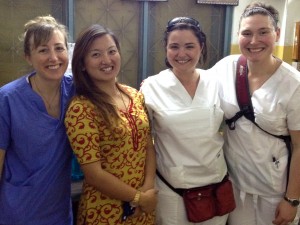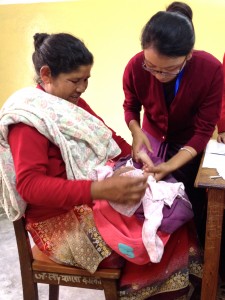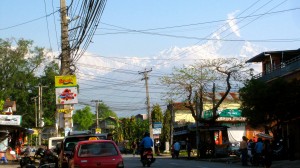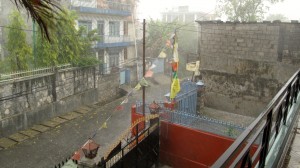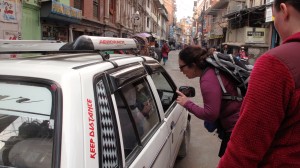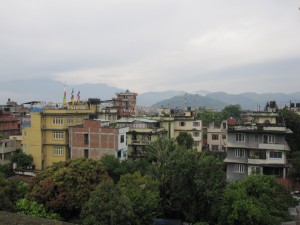In total, we spent 4 days in the Pokhara Gandaki Hospital. We observed for two days in labour and delivery, and spent two days in the antenatal clinic. While we have a LOT to write about, and much to think about because of this experience, we have also learned what we are made of.
All of the births we witnessed were very medicalized. Control by medicine seemed very important. It is far from birth as a psychosexual experience that I’ve been reading about in Sheila Kitzinger’s book, Birth and Sex (which at the moment, is also keeping me sane). In fact, it’s not even close to birth at home. Though to say I didn’t expect it wouldn’t be true – Cathy had briefed us on what birth was like at this hospital before we arrived. That said, seeing it in person is a lot different from hearing about it in anticipation.
The typical labour and birth at this particular hospital includes oxytocin induction (without prostaglandins first) or augmentation, labouring without support or pain medication in the first stage room (on benches, amongst 7 other women). Then, once full dilation is achieved, the woman is helped to the second stage room. There are three delivery tables in a room the size of our Midwifery Lab (for those who don’t know, it is small). The woman is put on the table, usually propped up (which is good), and instructed to push with contractions. Student nurses crowd each woman as she is pushing – with the other birthing women on tables in the room looking on in anticipation of their impending birth, or in relief of it being over.
Despite the use of oxytocin, fetal heart monitoring is done periodically with Pinard horns and fetoscopes. Once the head is visible, infiltration is conducted (if the woman protests the needle, then anaesthetic is not given) and an episiotomy is cut (without consent and with or without anaesthetic). With a few more pushes, the baby is born, placed swiftly on mom’s abdomen and wiped off. At the same time, the cord is immediately clamped and cut, and baby whisked off to the warmer. None of the babies we observed being born needed any resuscitation, and we were present for 7 births. Then the baby is bundled, handed off to a family member outside of the birthing unit, and the woman receives active management for the birth of the placenta.
Following the birth of the placenta, the women are sutured. They do infiltrate with lignocaine 2% diluted with sterile water, but don’t wait long enough for it to take effect or put in enough to adequately freeze the area being sutured (based on the squirming, screaming and heavy breathing of the women being sutured). During the time we were there, I found myself with two different women throughout the day, looking into their eyes, breathing with them, helping them maintain control over the pain of being sutured with inadequate anaesthetic. The nurses suturing don’t seem to connect the reaction of the woman to their handywork, which is very troubling, given that all the nurses are women themselves and this is a teaching hospital. Once the nurses finish suturing, the women are rolled off the table (as another woman is brought in) and directed to the postnatal room (of multiple women, babies and families). The whole process got us to thinking: if only the women weren’t cut, most wouldn’t need suturing, or would need very little, and would quickly be able to hop off the table with their babies and together head to the postnatal ward.
So, after watching this scene repeat itself 7 times, we decided we had had enough and needed to get ourselves to the nice part of Pokhara to decompress. We watched a particularly meaningful birth video from home (thank you Jessa!) and ordered some comfort food at our most favourite restaurant.
Maintaining control over our own emotions during such emotionally-charged moments has proven difficult, but very important. I can’t say I didn’t want to lose it multiple times over the course of that one day in labour and delivery. I also can’t say I didn’t choke back tears between births. This is so far from our norm and from the type of birth we wish for any of our clients. I am often left wondering how we got so lucky to be in Canada at a time when this sort of birth is foreign.
There is lots that needs to change based on these simple observations. Things that are as easy as reducing the number of students in the delivery room and inducing and augmenting labour only when medically indicated would be a good start. More difficult is encouraging system-wide change in order to comply with Nepali Health Policy, which includes immediate skin-to-skin, delayed cord clamping, restrictive episiotomy, and breastfeeding within the first hour.
However, what is most clear to me is how badly Nepal needs midwifery. The women of Nepal want midwives. In light of our experience in L&D, we took yesterday off to plan for a trip to an adjacent region that has fewer births, but is more open to change. In the evening, after our packing and debriefing, we hosted two maternity nurses at our guest house’s restaurant, discussed normal birth and showed several videos in Nepali about immediate postpartum care for mum and babe, and 8 danger signs in the newborn baby. What was remarkable was how intrigued each woman was! Our guest house owner, her mother and her daughter even tuned in as soon as we put the videos on. They locked all the doors to “keep the boys out!” It was so reaffirming to know that the work we are doing is important, and valued by the very women who have or will be accessing care.
And so, today, on the eve of our departure for another town, we find ourselves in tourist Pokhara once again to celebrate with lassis and tell our friends and family back home that despite the ups and downs of this journey, we are doing fine, and will continue striving to improve care for women in this part of the world.
Much love home.
